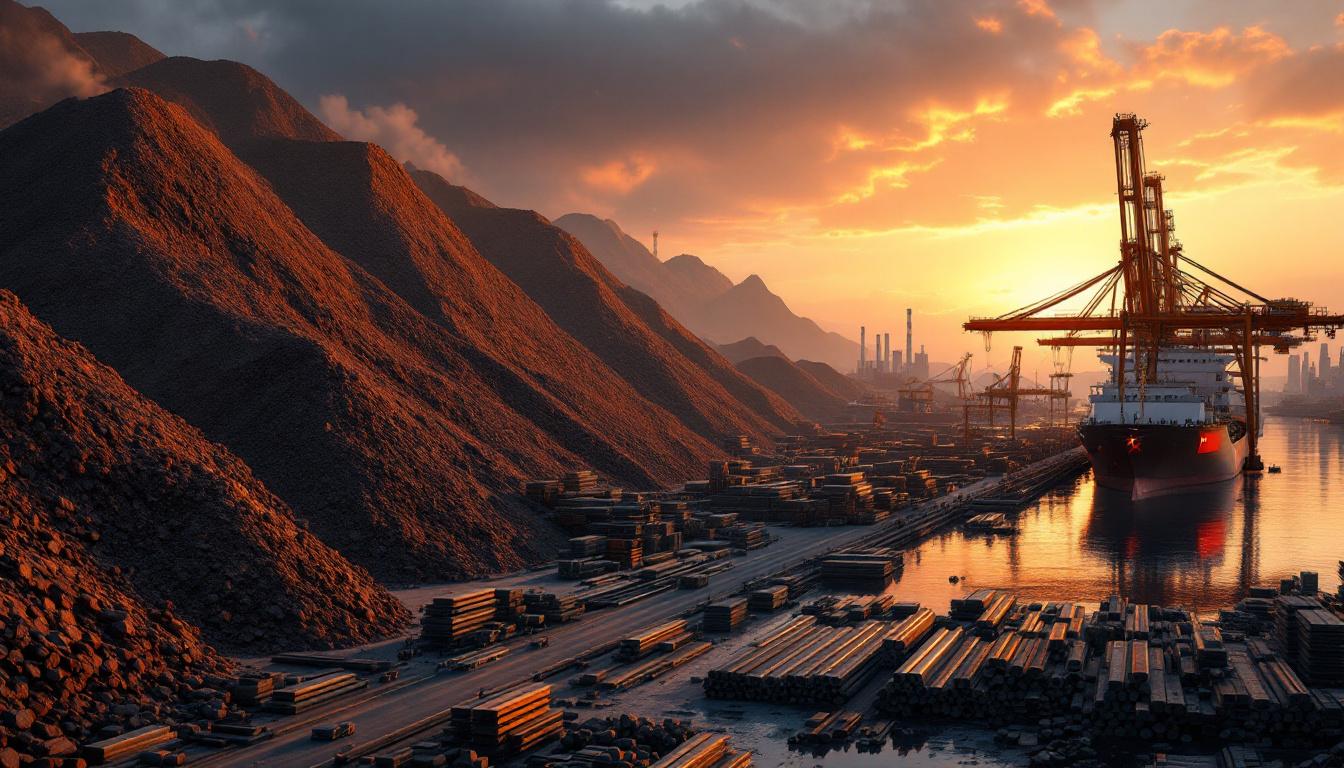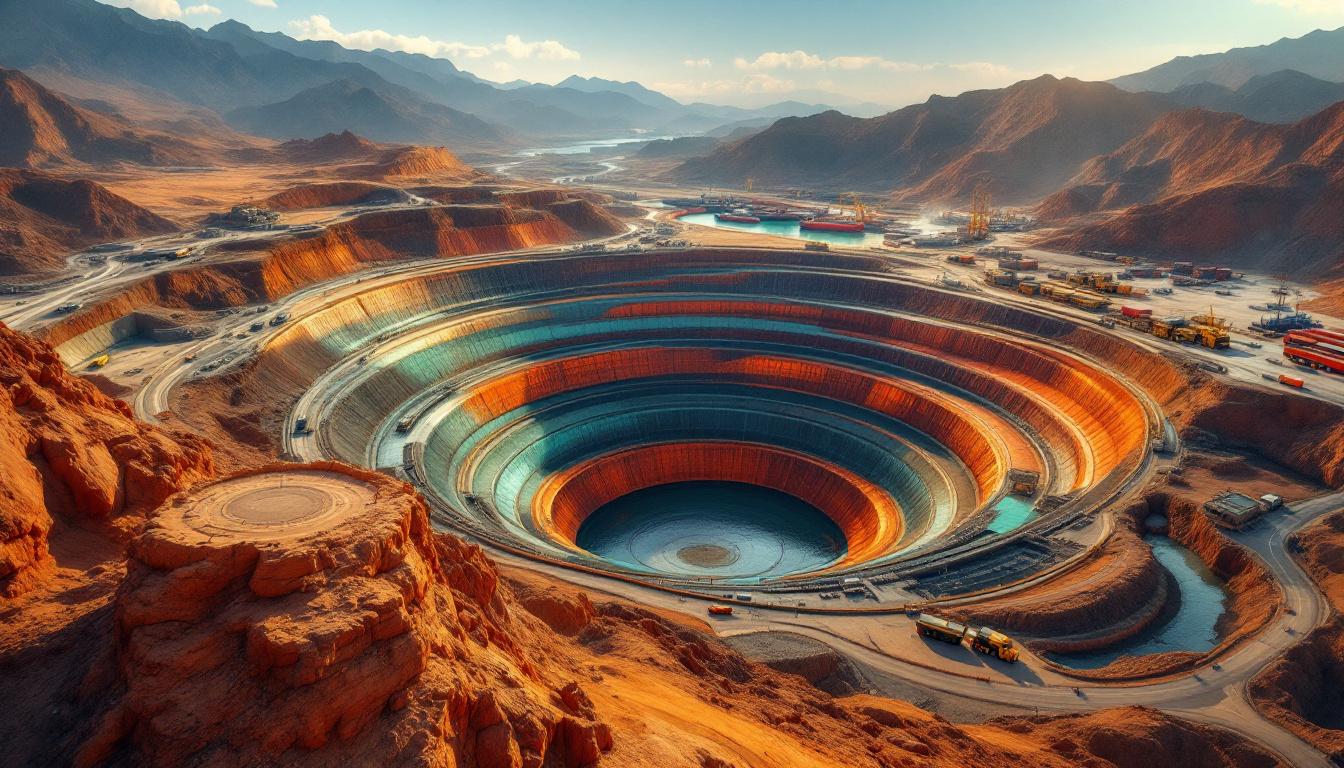China's Iron Ore Imports: The Paradox of Rising Demand Amid Steel Industry Struggles
China's iron ore imports are showing remarkable resilience in 2025, with June projected to be the strongest month this year at approximately 110 million metric tons. This represents an 11% increase from May's 98.13 million tons and approaches December 2024's near-record level of 112.49 million tons. This surge is particularly noteworthy given that China purchases roughly 75% of globally traded seaborne iron ore, making its import patterns crucial for global market dynamics.
What's Driving China's Increasing Iron Ore Imports?
The recent surge in China's iron ore imports can be attributed to strategic buying patterns that take advantage of market conditions. According to data from LSEG and Kpler, June 2025 imports are estimated between 109.1 and 109.56 million tons, representing the strongest monthly performance this year.
The Price Factor: Opportunistic Buying
The recent increase in imports appears strategically timed with iron ore price trends in the market:
- Singapore Exchange iron ore futures dropped to $94.17 per ton on June 18, 2025
- This marked the lowest price point since September 30, 2024
- Prices have been trending downward since reaching $107.81 per ton on February 12, 2025
- The steady price decline since mid-May likely encouraged opportunistic buying
As Clyde Russell, a commodities analyst at Reuters, noted: "The answer likely lies in price moves, with spot iron ore slipping to the lowest in eight months early in June." This counter-cyclical purchasing strategy—buying when prices fall—has been a consistent pattern in China's iron ore procurement approach.
Inventory Replenishment Strategy
Another significant driver behind the import surge is the strategic rebuilding of depleted stockpiles:
- Port inventories monitored by SteelHome reached a 16-month low of 132 million tons in early June 2025
- Current stockpiles of 133.4 million tons (as of June 13) remain 9% below the 146.6 million tons recorded in the same period of 2024
- The inventory rebuilding suggests Chinese buyers are taking advantage of lower prices to restock
This stockpile management strategy reflects sophisticated market timing by Chinese importers, who typically increase purchases when prices reach attractive levels. The lag between price movements and physical delivery—typically 2-3 weeks from Australian ports and 4-6 weeks from Brazilian terminals—means that June's import volumes reflect purchasing decisions made during the price declines of May.
Why Is China's Steel Sector Struggling Despite Strong Iron Ore Imports?
The disconnect between robust iron ore imports and a weakening steel sector presents a puzzling market dynamic that requires examination.
Declining Steel Production Metrics
Official data reveals a significant contraction in China's steel manufacturing:
- May 2025 production fell to 85.55 million tons, representing a 6.9% year-on-year decline
- Cumulative output for January-May 2025 reached 431.63 million tons, down 1.7% from the same period in 2024
- The China Iron and Steel Association projects a 4% annual decline in steel production for 2025
This contraction represents a fundamental shift in China's steel industry trajectory after decades of growth. The production decline is particularly noteworthy given that the country has historically prioritized steel output as a measure of industrial strength.
Domestic Market Headwinds
Several internal factors are suppressing steel demand within China:
- The property sector continues to struggle despite recent stimulus measures
- New home prices decreased 0.2% month-on-month in May 2025 after stagnating in April
- Construction activity, a major steel consumer, remains subdued
- Domestic steel prices have weakened, with Shanghai Exchange rebar contracts falling to 2,982 yuan ($414.74) per ton by mid-June 2025
- This represents a 14% decline from the February peak of 3,466 yuan
The property sector's importance to steel consumption cannot be overstated. In China, construction accounts for approximately 35% of total steel usage, with residential building being the largest component. The continuing decline in new home prices—despite government attempts to stabilize the market—indicates persistent structural weakness rather than a cyclical downturn.
International Trade Pressures
While domestic consumption weakens, China's steel exports have provided some counterbalance:
- May 2025 steel exports jumped nearly 10% year-on-year to 10.58 million tons
- The January-May 2025 period saw record exports of 48.47 million tons, up 8.9%
- However, growing protectionist measures from trading partners threaten this outlet
- US tariffs impact on iron ore markets could be substantial with potential tariffs up to 55% on Chinese imports
- India has also implemented protective measures against Chinese steel
As noted in the MINING.com analysis: "The problem for China's steel exports is that they may become a victim of their own success as other countries ramp up protectionism." This export vulnerability creates additional uncertainty for the steel sector and, by extension, future iron ore demand.
How Are Iron Ore Price Dynamics Affecting Market Behavior?
The relationship between iron ore prices and import volumes reveals important market mechanics at work in 2025.
Price Trends and Import Patterns
Historical data shows a complex relationship between pricing and purchasing behavior:
- The eight-month low in iron ore prices during early June 2025 coincided with increased buying activity
- There is typically a lag between price movements and import volumes due to shipping timeframes
- The current import surge reflects decisions made during earlier price decline analysis
- Chinese buyers appear to be implementing a counter-cyclical purchasing strategy
This pattern demonstrates sophisticated market timing by Chinese importers, who have developed expertise in balancing price considerations with inventory needs. The shipping lag—approximately 2-3 weeks from Australia and 4-6 weeks from Brazil—means that June's robust imports reflect decisions made during May's price declines.
Supply-Demand Imbalance Indicators
The divergence between iron ore imports and steel production points to potential market inefficiencies:
- Iron ore imports growing at 11% month-on-month while steel production falls 6.9% year-on-year
- This mismatch suggests either inventory building or production inefficiencies
- The sustainability of this pattern depends on whether steel demand recovers
- If steel production continues declining as projected, iron ore imports may eventually follow
This divergence creates a fundamental question about sustainability. While short-term stockpiling may explain the current pattern, the longer-term trajectory must eventually align with actual steel production needs. The persistence of this imbalance will likely depend on whether Chinese steel mills anticipate a demand recovery in the second half of 2025.
What's the Outlook for China's Iron Ore and Steel Markets?
Several factors will determine the trajectory of China's iron ore imports and steel production in the coming months.
Potential Market Corrections
The current divergence between iron ore imports and steel production appears unsustainable:
- If steel demand remains weak, iron ore imports will likely adjust downward
- The inventory rebuilding phase may be temporary
- Price sensitivity will continue to influence purchasing decisions
- The China Iron and Steel Association's projection of a 4% annual decline in steel output suggests continued pressure
Market analysts anticipate that the current inventory-building cycle will eventually reach its limits, particularly if the property sector continues to underperform. The CISA forecast of a 4% decline in annual steel output—a significant reversal from historical growth patterns—suggests that iron ore imports must eventually reflect this new reality.
External Market Influences
Global trade dynamics will significantly impact China's steel sector:
- Rising protectionism threatens China's growing steel export market
- Potential 55% tariffs from the United States would substantially reduce export opportunities
- Similar protective measures from other countries could further constrain export growth
- These external pressures may eventually reduce iron ore demand
The protectionist measures being considered by major economies represent a serious threat to China's steel export growth. With domestic consumption stagnant, exports have become an essential outlet for excess production. Any significant reduction in export opportunities would likely accelerate the decline in steel output and, consequently, iron ore imports.
Strategic Considerations for Market Participants
The current market conditions present both challenges and opportunities:
- Iron ore producers may face weakening demand if steel production continues declining
- Steel manufacturers must navigate both domestic consumption challenges and export restrictions
- Traders can potentially capitalize on price volatility and inventory management strategies
- The property sector's recovery remains crucial for domestic steel demand
Market Perspective: "The divergence between rising iron ore imports and falling steel production creates an unsustainable tension in the market. Either steel demand must recover, or iron ore imports will eventually decline to match the new production reality."
For market participants, the key question is timing. How long can the current divergence between imports and production persist? The answer likely depends on both inventory capacity limits and price movements. If prices continue to decline, Chinese buyers may extend their inventory building even as production falls. Conversely, any significant price recovery could quickly dampen import volumes.
FAQ: China's Iron Ore and Steel Market Dynamics
Why are China's iron ore imports increasing while steel production is declining?
The divergence is primarily driven by opportunistic buying during price dips and strategic inventory rebuilding after stockpiles reached 16-month lows. Chinese buyers are taking advantage of iron ore prices that hit eight-month lows in June 2025.
How significant is China's role in the global iron ore market?
China purchases approximately 75% of globally traded seaborne iron ore, making it the dominant player in determining market dynamics and pricing.
What factors are suppressing China's steel sector in 2025?
The ongoing property sector slump, declining new home prices, weak domestic consumption, and growing international trade barriers are collectively constraining steel demand and production.
How have iron ore prices trended in 2025?
Iron ore futures on the Singapore Exchange have declined from $107.81 per ton in February to $94.17 in mid-June, representing a significant downward trend that has influenced buying behavior.
What is the current state of China's iron ore inventories?
Port stockpiles stood at 133.4 million tons as of mid-June 2025, which is 9% below the same period in 2024, despite recent rebuilding efforts from the 16-month low reached in early June.
Key Statistics: China's Iron Ore and Steel Market (2025)
| Metric | Value | Change |
|---|---|---|
| June 2025 Iron Ore Imports (Forecast) | ~110 million tons | +11% from May |
| May 2025 Steel Production | 85.55 million tons | -6.9% year-on-year |
| Jan-May 2025 Steel Production | 431.63 million tons | -1.7% year-on-year |
| May 2025 Steel Exports | 10.58 million tons | +10% year-on-year |
| Jan-May 2025 Steel Exports | 48.47 million tons | +8.9% year-on-year |
| Iron Ore Price (June 18, 2025) | $94.17 per ton | Lowest since Sept 2024 |
| Iron Ore Price (Feb 12, 2025) | $107.81 per ton | 2025 high |
| Current Iron Ore Port Inventory | 133.4 million tons | -9% year-on-year |
Disclaimer: This analysis is based on current market conditions and projections. The commodities markets are inherently volatile and subject to rapid changes based on economic, political, and supply chain factors. Readers should consult with financial advisors before making investment decisions based on this information.
Further Exploration:
Readers interested in learning more about China's iron ore import patterns and steel industry challenges can also explore related educational content from Bloomberg's analysis of China's iron ore market, which offers regular updates and analysis on global commodity markets and trade dynamics. Additionally, Reuters' comprehensive reporting on China's steel struggles provides valuable insights into the evolving situation.
The current market data suggests we may see a significant iron ore mining surge through the remainder of 2025, though this will depend heavily on China's economic policies. Analysts studying the iron ore forecast 2025 continue to monitor these evolving dynamics closely as they could signal major shifts in global commodity markets.
Want to Spot the Next Major Mining Discovery Before the Market?
Discovery Alert's proprietary Discovery IQ model instantly notifies investors of significant ASX mineral discoveries, transforming complex mining announcements into actionable investment insights. Explore how historic discoveries have generated substantial returns by visiting our dedicated discoveries page and position yourself ahead of the market.




